The Best Low-Flow Toilets for Eco-Friendly Bathrooms
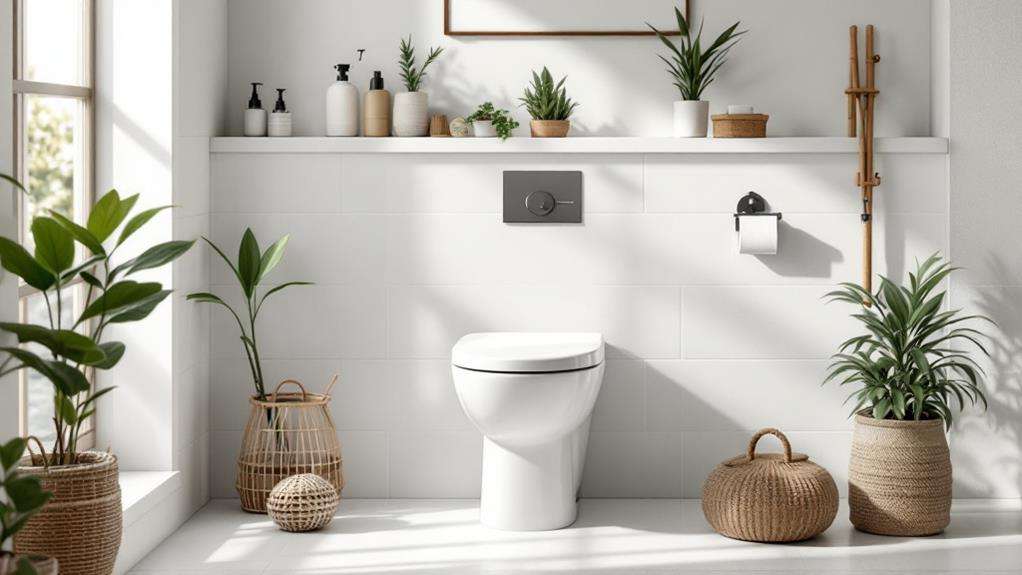
Low-flow toilets are essential for eco-friendly bathrooms, offering significant water savings without compromising performance. Top models include the Niagara Stealth Toilet, using just 0.8 gallons per flush, and the Kohler Memoirs Stately Toilet, which meets WaterSense requirements at 1.28 GPF. Dual-flush options provide even greater water efficiency, with potential savings of up to 60%. When choosing a low-flow toilet, look for WaterSense certification and MaP ratings of 350+ grams for optimal performance. By upgrading to a water-efficient toilet, you'll save money on utility bills and reduce your environmental impact. Dive deeper to discover how these innovative fixtures can transform your bathroom.
Key Takeaways
- WaterSense-certified toilets use 1.28 gallons per flush or less, saving up to 13,000 gallons annually per household.
- Top single-flush models include Niagara Stealth (0.8 GPF), Kohler Memoirs Stately (1.28 GPF), and Toto Vespin II (1.0 GPF).
- Dual-flush toilets offer customizable water usage, potentially saving up to 60% more water than traditional models.
- Look for toilets with MaP ratings of 350+ grams to ensure effective solid waste removal performance.
- Low-flow toilets can result in annual utility bill savings of up to $140, paying for themselves within seven years.
Understanding Low-Flow Toilet Technology
Low-flow toilets' technology has come a long way since their introduction in the early 1990s. Today's models offer impressive water savings without compromising performance. WaterSense-labeled toilets use no more than 1.28 gallons per flush, significantly less than older models. This efficiency can save your household up to 13,000 gallons of water annually when replacing an outdated toilet.
Advanced flushing technology ensures effective waste removal, addressing early concerns about low-flow toilets' effectiveness. Dual-flush options provide even more water-saving potential, allowing you to choose between a full flush for solid waste and a reduced flush for liquid waste. This feature can cut water usage by up to 60%.
To evaluate a low-flow toilet's performance, look for its MaP rating. This standardized system measures flushing effectiveness, with ratings of 350+ grams indicating good performance. When shopping for a new toilet, consider models with high MaP ratings to ensure you're getting a water-efficient option that doesn't sacrifice functionality. By choosing a well-designed low-flow toilet, you'll contribute to water conservation efforts while maintaining a clean and efficient bathroom.
Benefits of Water-Efficient Toilets
Building on the advancements in low-flow toilet technology, it's important to understand the substantial benefits these water-efficient fixtures offer. By replacing your old toilet with a WaterSense-certified model, you'll significantly reduce your household's water consumption. These water-efficient toilets can save the average family an impressive 13,000 gallons of water annually, translating to over $140 in utility bill savings each year.
Don't worry about sacrificing performance for efficiency. Modern low-flow toilets that use 1.28 gallons per flush or less are highly effective at removing solid waste and cleaning the bowl. In fact, EPA testing shows they perform as well as or better than their higher-gallon counterparts.
The impact of water-efficient toilets extends beyond your home. If everyone in the nation upgraded to these models, we could save a staggering 520 billion gallons of water each year. This massive water savings would significantly reduce our overall environmental footprint. By choosing a water-efficient toilet, you're not only benefiting your wallet but also contributing to a more sustainable future for everyone.
Top Single-Flush Low-Flow Models
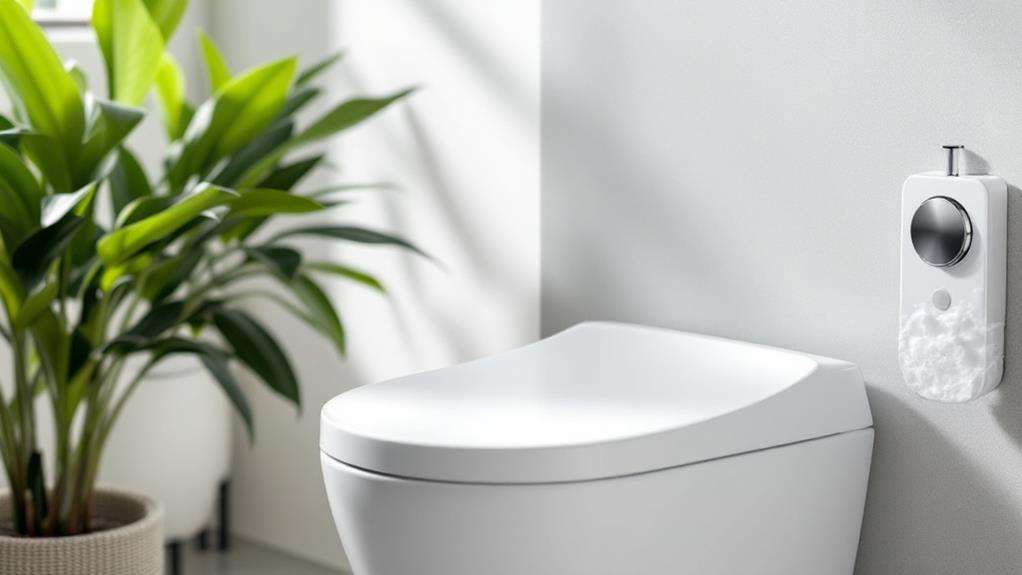
Among the wide array of water-efficient toilets available, single-flush low-flow models stand out for their simplicity and effectiveness. These toilets offer substantial water and cost savings over their lifetime compared to older, high-flow models, making them an excellent choice for eco-friendly bathrooms.
One standout option is the Niagara Stealth Toilet, which uses an impressive 0.8 gallons per flush (GPF). That's half the water consumption of standard 1.6 GPF toilets, significantly reducing your water usage and utility bills. If you're looking for a balance between water efficiency and powerful flushing performance, consider the Kohler Memoirs Stately Toilet. It uses 1.28 GPF, meeting the EPA WaterSense label requirements while still delivering robust flushing capability.
For those seeking advanced technology, the Toto Vespin II 1G Two-Piece Toilet is an excellent choice. With its 1.0 GPF and Tornado Flush technology, it provides effective cleaning while conserving water. All three models offer water efficiency without compromising performance, ensuring you'll have a reliable, eco-friendly toilet in your bathroom. By choosing one of these single-flush low-flow models, you're not only reducing your environmental impact but also saving money in the long run.
Dual-Flush Toilets Explained
While single-flush low-flow toilets offer impressive water savings, dual-flush toilets take water conservation to the next level. These innovative fixtures provide two flush options: a full flush for solid waste and a reduced-volume flush for liquid waste. By allowing you to use only the amount of water needed, dual-flush toilets can save 20-60% more water than standard models.
Dual-flush toilets typically use between 0.8 and 1.6 gallons per flush, significantly reducing water usage compared to traditional toilets. Advanced flushing technology ensures effective cleaning with less water, making these fixtures both eco-friendly and efficient.
Here are five key benefits of dual-flush toilets:
- Customizable water usage based on waste type
- Significant water savings of up to 60%
- Advanced cleaning technology for effective flushing
- Timer-based systems for automatic flush selection
- Potential for nationwide water conservation
Some dual-flush models even feature timer-based systems that automatically select the appropriate flush volume, further optimizing water efficiency. If widely adopted across the United States, dual-flush toilets could save hundreds of billions of gallons of water annually. By choosing a dual-flush toilet for your bathroom, you're not only reducing your water bill but also contributing to a more sustainable future.
WaterSense Certification and Standards
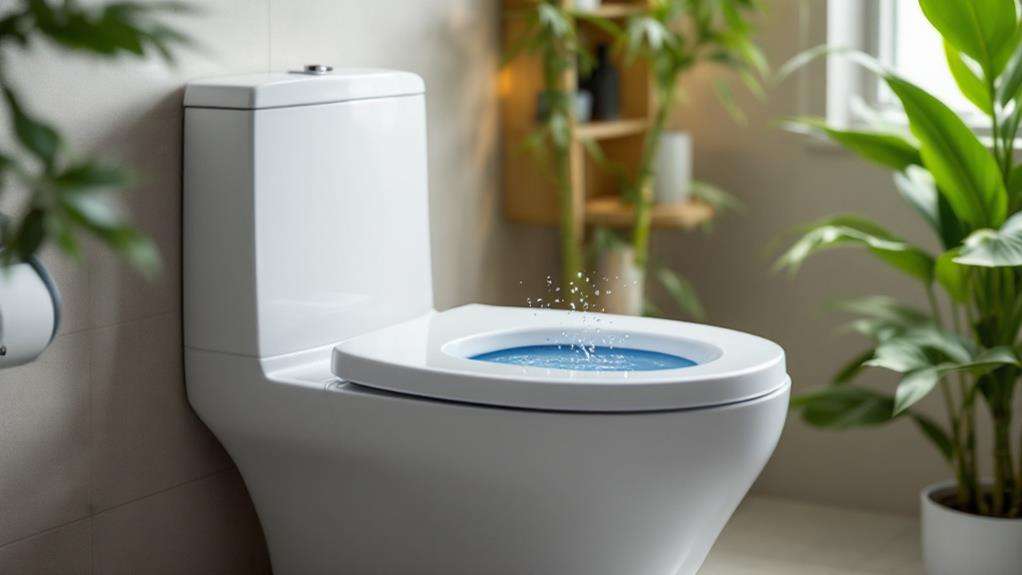
WaterSense certification stands out as a crucial factor when you're shopping for a low-flow toilet. This EPA program sets rigorous standards for water-efficient plumbing fixtures, ensuring you're getting a truly eco-friendly product. WaterSense certified toilets use at least 20% less water than the federal standard of 1.6 gallons per flush (GPF), with a maximum of 1.28 GPF.
But it's not just about using less water. These toilets must also pass strict performance tests to ensure they flush effectively. By choosing a WaterSense labeled toilet, you're not only conserving water but also maintaining high performance standards in your bathroom.
The impact of these water-efficient toilets is significant. Your family could save up to 13,000 gallons of water annually by upgrading to a WaterSense model. On a larger scale, if WaterSense toilets were adopted nationwide, we could save a staggering 520 billion gallons of water each year. When shopping for a new toilet, look for the WaterSense label to identify the most water-efficient options available. It's a simple way to make a big difference in your home's water consumption and environmental impact.
Performance Ratings and Testing
When choosing a low-flow toilet, you can't rely on water efficiency alone. You'll need to consider performance ratings and testing to ensure you're getting a toilet that's both eco-friendly and effective. The Maximum Performance (MaP) rating is a crucial metric to look for, with scores of 350+ grams indicating good performers and 600+ grams signifying excellent solid waste removal.
While WaterSense certification guarantees water efficiency, it doesn't tell the whole story. Proper performance testing involves evaluating:
- Bowl cleaning effectiveness
- Full flushing coverage
- Solid waste removal capabilities
- Ability to handle various materials
- Consistency across multiple flushes
Consumer Reports engineers put toilets through rigorous evaluations, including flushing plastic balls, sponges, and screws. These tests simulate real-world scenarios and help identify toilets that can handle diverse waste types effectively.
When selecting a high-efficiency toilet, don't just focus on water savings. Review independent, third-party performance test results to ensure you're getting a toilet that cleans thoroughly while conserving water. By considering both WaterSense certification and MaP ratings, you'll find a low-flow toilet that meets your eco-friendly goals without compromising on performance.
Cost Savings and ROI
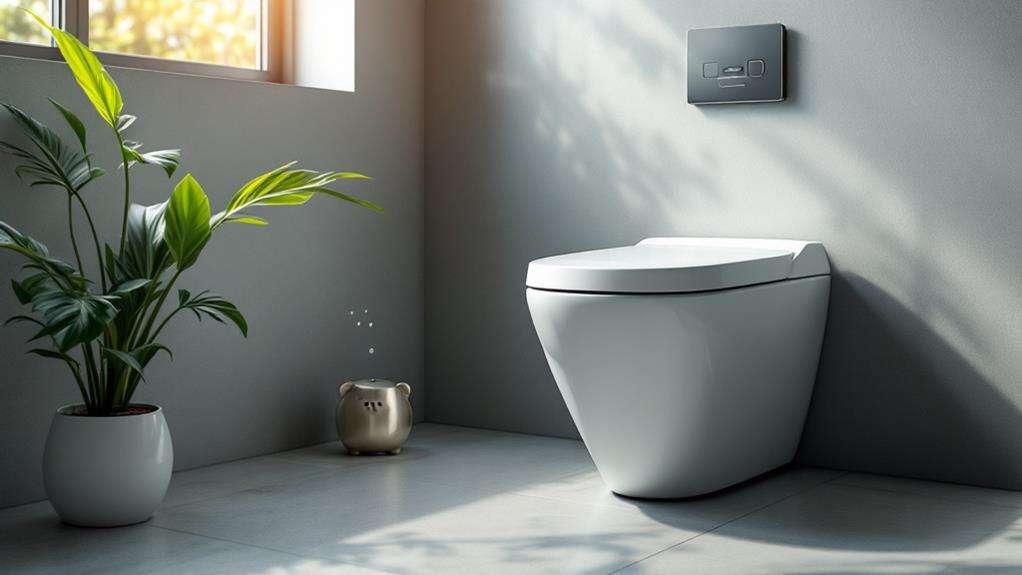
Performance isn't the only factor to consider when choosing a low-flow toilet. The potential cost savings and return on investment (ROI) are compelling reasons to make the switch. By upgrading to a WaterSense certified model, you can save up to $140 per year on your utility bill. This significant reduction in water usage not only helps the environment but also puts money back in your pocket.
While the upfront cost of a high-efficiency toilet may be higher, it's important to consider the long-term benefits. On average, a low-flow toilet can pay for itself in less than seven years through water and utility bill savings. This makes it a worthwhile investment for most homeowners.
The impact of switching to water-efficient toilets extends beyond individual households. If adopted nationwide, these toilets could save 360 billion gallons of water annually. To put this into perspective, that's equivalent to the amount of water flowing over Niagara Falls for nine days. By choosing a low-flow toilet with a high Maximum Performance (MaP) rating, you'll save water and money without compromising on flushing effectiveness.
Environmental Impact of Low-Flow Toilets
A single flush can make a world of difference. When you upgrade to a low-flow toilet, you're not just saving water; you're actively reducing your environmental impact. These eco-friendly fixtures can save your family up to 13,000 gallons of water annually, significantly cutting down on your household's water use.
The benefits of low-flow toilets extend far beyond your home. If everyone in the U.S. switched to WaterSense certified models, we'd save a staggering 520 billion gallons of water each year. That's a massive step towards addressing global water scarcity. By choosing a water-efficient toilet, you're contributing to:
- Reduced strain on freshwater resources
- Lower energy consumption for water treatment
- Decreased carbon footprint of plumbing systems
- Conservation of drinking water
- Mitigation of water scarcity issues
With toilets accounting for over 30% of household water consumption, they're a prime target for water conservation efforts. Low-flow and dual-flush technologies offer effective waste removal while dramatically reducing water use. By making this simple switch, you're not just saving money – you're actively participating in a crucial environmental solution.
Installation and Maintenance Tips
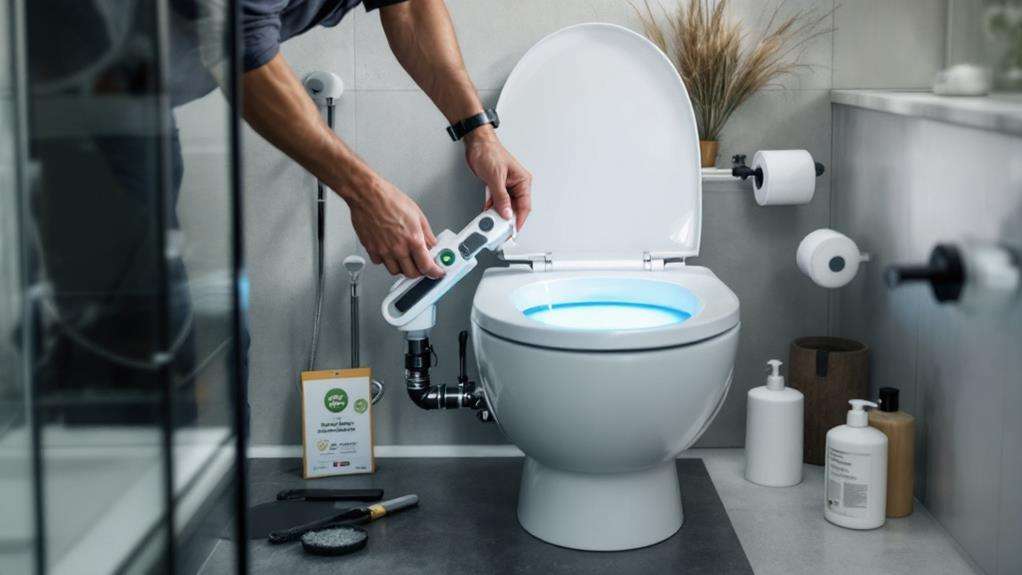
To get the most out of your low-flow toilet, proper installation and maintenance are key. Start by hiring a qualified plumber to ensure your new water-efficient plumbing fixture is installed correctly. This step is crucial for optimal performance and water conservation.
Once installed, focus on regular maintenance to keep your low-flow toilet running efficiently. Check for leaks periodically and clean the tank and bowl as recommended by the manufacturer. Don't forget to flush the toilet regularly, even when it's not in use, to prevent mineral buildup that can compromise its water-saving capabilities.
If you have an older low-flow model, consider upgrading the flush valve or flapper. This simple modification can often improve water use without requiring a full toilet replacement.
Always follow the manufacturer's care and cleaning instructions to maximize your toilet's lifespan and savings. By properly maintaining your low-flow toilet, you'll ensure it continues to conserve water effectively for years to come.
Alternatives to Traditional Toilets
While low-flow toilets offer significant water savings, they're not the only eco-friendly option available for your bathroom. Consider these alternatives that can drastically reduce or eliminate water usage:
Composting toilets utilize natural decomposition processes to transform human waste into nutrient-rich compost. They require little to no water, making them an excellent choice for environmentally conscious homeowners. Incinerating toilets, on the other hand, use electricity to incinerate waste, turning it into sterile ash. These water-free solutions are particularly suitable for remote areas where traditional plumbing may not be feasible.
If you're not ready to make such a drastic change, consider installing WaterSense fixtures throughout your bathroom. These EPA-labeled products reduce water usage by at least 20% compared to standard fixtures, helping you conserve water without sacrificing performance.
Here are some benefits of exploring alternative toilet options:
- Significant reduction in water consumption
- Lower utility bills
- Reduced environmental impact
- Potential for off-grid living
- Valuable compost production (for composting toilets)
